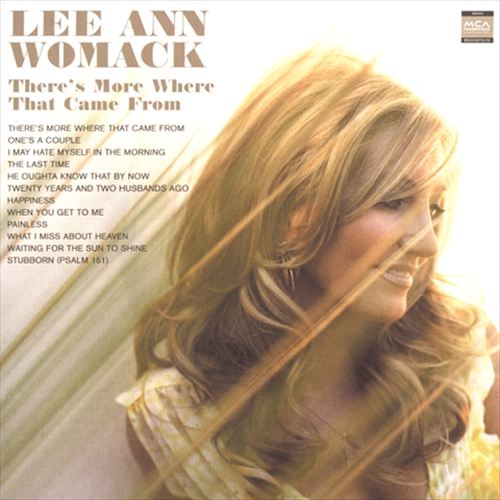There's More Where That Came From
| Lee Ann WomackThere's More Where That Came From
Critic Reviews
Show All-
 All Music
All Music
There's More Where That Came From, her fifth proper studio album and first after her 2004 Greatest Hits compilation, is still firmly within the country-pop confines, but there's a notable difference -- as the rather brilliant cover art suggests, this hearkens back to the sound and style of early-'70s country-pop albums from the likes of Barbara Mandrell, Loretta Lynn, and Dolly Parton.
-
 Saving Country Music
Saving Country Music
There’s More Where That Came From deserves to be enshrined on the very top row of country music’s landmark records in history. But it might be the best effort from one of modern country music’s best singers, and at the time it was such a bold, unabashed expression from someone reasserting her own voice, it works as a great lesson of what to do, and what not to do in country music.
-
 Country Universe
Country Universe
Lee Ann’s new album makes me feel that feeling, over and over again. Each track speaks a different truth. To discuss them individually would be an endless exercise of searching for new adjectives that say the same thing; I’ll limit myself to the two tracks that soar above and beyond to be better than the best.
-
 Texas Monthly
Texas Monthly
In a decade of new country, Womack strikes this chord with an age-old voice: a powerful, cake-sweet soprano that sings like it talks, in small-town cain’t’s and git’s. And if she works the sob in a line, she shows restraint where Reba McEntire would do a triple-gainer.
-
 Digital Journal
Digital Journal
It is an acoustic vocal, where her vocals are piercing and haunting, while simultaneously honey-rich. Womack's talent is a rare combination for sure.
-
 CMT
CMT
There’s More Where That Came From won album of the year at the CMA Awards in New York City in 2005.
-
 CBS News
CBS News
"There's More Where That Came From" also features songs such as "Stubborn," which she performed for The Early Show, and "I May Hate Myself In The Morning (But I'm Gonna Love You Tonight)." In essence, the album only includes pure country songs making it a favorite since its release.
-
 Country Standard Time
Country Standard Time
The album cover has a retro look and is even out in vinyl! It continues with the title track where a fiddle sets the tempo, and Womack's lovely, heartfelt voice takes over. And perhaps most indicative of the stylistic change is that Womack isn't afraid to tackle what may be a cheating song (the title track) or two, something country used to know a lot more about about.
-
 Gazette Review
Gazette Review
Her sixth studio album, There’s More Where That Came From was released in February 2005. Unlike her previous effort back in 2002, this album garnered much widespread attention; it would eventually outrank I Hope You Dance as her best-selling album to date. Notable for its traditional country sounds, the album featured thirteen songs and peaked at number three on the Top Country Albums Chart and at number twelve on the Billboard 200.
-
 Slant Magazine
Slant Magazine
There’s More Where That Came From, earned raves for a lush, traditional countrypolitan production that was a perfect fit for Womack’s hard-country sense of phrasing, her latest effort is characterized by a stylistic diversity and an insistence on playing against her strengths.
-
 My Kind Of Country
My Kind Of Country
There’s More Where That Came From was released at a time when things had moved decidedly toward the pop end of the spectrum and when the youth movement was in full force, leaving artists over the age of 40 at a distinct disadvantage. It is therefore, a little surprising that Lee Ann was allowed to release what could only have been viewed at the time as a non-commercial album, but her career had nosedived so badly by that time, her label perhaps felt that there was nothing left to lose.
-
 Pop Matters
Pop Matters
It's not a revolution, it's not a bold new path, it's nothing more than good old country music, schmaltz and truth and hurt and illicit sex all wrapped up together with a pretty and garishly red bow.
-
 Napster
Napster
Lee Ann Womack's There's More... is an album steeped in an old-school country tradition: tales of dead-end relationships, cheating and broken hearts abound. The traditional-sounding arrangements -- featuring steel guitar, piano, harmonica and fiddle, -- help color a page from a bygone era, leaning heavily on the sepia-toned '70s for a classic, "old country" sound.
-
 Oldies
Oldies
Though Lee Ann Womack's voice has always betrayed the influence of 1960s and '70s country music, prior to THERE'S MORE WHERE THAT CAME FROM, her albums often concentrated on sophisticated Nashville pop-country. The vintage-style soft-focus cover photo and faux record dust jacket here, however, immediately signal a change of direction.
-
 Humphead Country
Humphead Country
There's More Where That Came From is for everyone who's ever loved, lost, and learned hard-earned lessons and lived to tell about it.
-
 Chron
Chron
Texas gal Womack returns to her twangy roots on There's More Where That Came From, which finds inspiration in classic country's leading ladies, including Tammy Wynette, Connie Smith, Janie Fricke and Dolly Parton.
-
 Billboard
Billboard
Whether singing heartbreaking ballads about love gone wrong, or smoldering three-minute epics about the attraction that lingers long after conventional wisdom would have you believe it should have died, there’s an honesty when Lee Ann Womack sings. You can hear it in her emotional delivery when she talks about making a decision that she knows is wrong, but can’t help herself.
-
 Nuts About Country
Nuts About Country
There's More Where That Came From is most likely going to prove to be prophetic when it comes to hit songs for Lee Ann Womack.
-
 No Depression
No Depression
There’s More Where That Come From is just about all heartbreak all the time; the singer is beset throughout by the burning memories of all the men she’s loved but who are now long gone.
-
 New York Times
New York Times
In 2005 she released “There’s More Where That Came From,” her best album and a triumph of yesteryear thinking. The songs were a throwback to country music of the late ’60s and early ’70s thickly orchestrated but hazy, cutting but polite.



Rate This Album and Leave Your Comments